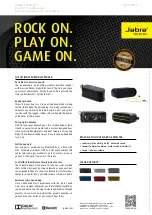
-
17
-
IS 3.5 - 4.0 - 5.0 - 6.0
IMPORTANT
The control panel is indispensable for operating the
unit and must be installed; do not use devices othet
than the control panel supplied with the unit since
they might not be compatible with the generator.
Make the connections with the battery disconnected.
CAUTION
The control panel is provided with a connecting
cable 10 metres long. This cable should not be
modified since it might cause the panel circuit to
function incorrectly.
4.3.
A.C. Connection
This connection can be done through the power terminal
board (fig. 15, ref. 1) placed inside the derivation box.
This range includes the possibility of use both at 110V
50Hz - 120V 60Hz and 220V 50Hz - 240V 60Hz.
For this reason it is possible to make two types of
connection (and use), according to the following
configurations.
1
- Parallel configuration: in this configuration there is a
single output at 110 (120) V between points P
1
and F
2
,
connecting the outputs of the alternator (P
1
, F
1
, P
2
, F
2
)
as shown in the diagram in fig. 16.
2
- Serial connection; in this configuration it is possible
to use a voltage of 220 (240) V between points P
1
and
F
2
, as shown in the diagram in fig. 17.
In serial connection, power can be picked up both at 110
(120) V between points F
1
- F
2
and P
1
- P
2
and at 220 (240)
V between points P
1
and F
2
at the same time, as shown
in the diagram in fig. 18.
It is also possible to feed two separate lines as shown in
fig. 19 on the outputs P
1
- F
1
and P
2
- F
2
.
N.B.
In this case the power which can be taken from each of
the two outputs is half the rated nominal power.
dèmarrage et d'arrèt (figure 14 - rèf. 3/4/5).
Pour fixer le tableau de commande, rèaliser un orifice
selon Figure 14.
IMPORTANT
Le tableau de commande doit ètre nècessairement
installè car il est indispensable pour le
fonctionnement du groupe: ne pas utiliser d'autres
dispositifs, diffèrents de la commande livrèe avec le
groupe, car ils pourraient ne pas ètre compatibles
avec le gènèrateur.
Brancher après avoir dèconnectè la batterie.
ATTENTION
Le tableau de commande est livrè avec un càble de
liaison de 10 mètres. Il est important que ce càble ne
soit pas modifiè; il pourrait en dèriver un
fonctionnement inadèquat du circuit du tableau de
commande.
4.3.
Raccordement c.a.
Ce raccordement est rèalisable gràce au bornier de
puissance (figure 15, rèf.1).
Cette gamme prèvoit la possibilitè d'une utilisation aussi
bien à 110 V 50 Hz - 120 V 60 Hz qu'à 220 V 50 Hz - 240
V 60 Hz.
Deux types de raccordements (et donc d'utilisation) sont
par consèquent possibles selon les configurations
suivantes:
1 -
Liaison en parallèle: dans cette configuration nous
avons une seule sortie à 110 (120) V entre les points
P1 et F2, en reliant les sorties de l'alternateur (P1, F1,
P2, F2) selon le schèma de la figure 16.
2
- Liaison en sèrie: dans cette configuration on peut
prèlever la puissance à une tension 220 (240) V entre
les points P1 et F2 selon le schàma de la figure 17.
Dans la liaison en sèrie on peut pr_lever simultanèment la
puissance à une tension de 110 (120) V entre les points
F1-F2 et P1-P2 qu'à une tension de 220 (240) V entre les
points P1 et F2, selon le schèma de la figure 18.
On peut en outre alimenter deux lignes sèparèes selon la
figure 19 sur les sorties P1-F1 et P2-F2.
NOTE:
Dans ce cas la puissance que l'on peut prèlever de
chacune des deux sorties est la moitiè de celle nominale
figurant sur la plaque.
Summary of Contents for IS 3.5
Page 30: ......














































